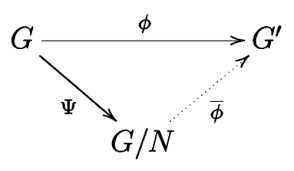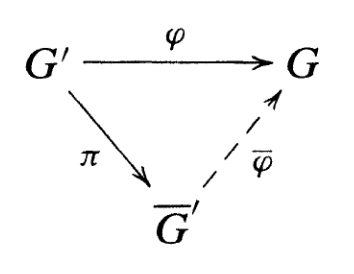Isomorphisms
Definition 1.
Let and be groups. A bijection is called an isomorphism if
If there exists an isomorphism from to , we say and are isomorphic and write .
Theorem 2(Lemma).
If is an isomorphism, so is .
Note that is well defined because is a bijection.
This lemma shows that when is an isomorphism, we can make a computation in either group, then use or to carry it over to the other. So, for computation with the group law, the two groups have identical properties. For example, if has order , then also has order . Similarly, if is a subgroup of , then is a subgroup of (this is also true for vanilla homomorphisms, but being an isomorphism also guarantees ).
Automorphisms
Recall that, if is a homomorphism,
- , .
- is an isomorphism if and .
is called an automorphism if . The set of all automorphisms is denoted by .
Theorem 3(Lemma).
Let be a group. Then, is a group under composition.
Proof
The identity isomorphism is the identity element. Let . Consider the map . Since and are bijective, is too. It remains to show that is a homeomorphism: . Thus, is closed under composition. For any , is well defined and bijective, is a homomorphism (easy to check), and hence is an isomorphism: .
Conjugation
The most important type of automorphism is conjugation: let be a fixed element of a group . Conjugation by is the map defined by . This is an automorphism because, first of all, it is a homomorphism, and second, it is bijective because it have an inverse function: conjugation by .
Two elements are called conjugates if for some . Conjugates have similar algebraic behavior, since they are the images of each other under an isomorphism.
Theorem 4(Lemma).
If , , then , and .
Proof
is the image of a group under an homomorphism.
Theorem 5(Corollary).
If a group has just one subgroup of order , then that subgroup is normal.
Projection maps
Theorem 6(Lemma).
Let be a group and . Then the map given by is a surjective homomorphism.
is known as the projection map.
Proof
is clearly well-defined (each maps to only coset in ). is a homomorphism: . It is clearly surjective.
Note that .
Exact chains
Note that in the above lemma, we have the following chain of homomorphisms, where and represent inclusion maps:
Note that the image of one map is the kernel of the following map in the chain.
First isomorphism theorem
Theorem 7.
Let be a homomorphism, and let be a projection map. Then, there exists a unique injective homomorphism such that . In other words, .
Proof
Define . Note that is a unique, well defined, injective homomorphism.
Mapping property of quotient groups
Theorem 8.
Let be a homomorphism, and let such that . Let , and let be the canonical projection map . The rule defines a homomorphism , and .
This mapping property generalizes the first isomorphism theorem. The hypothesis that be contained in is essential, of course.

